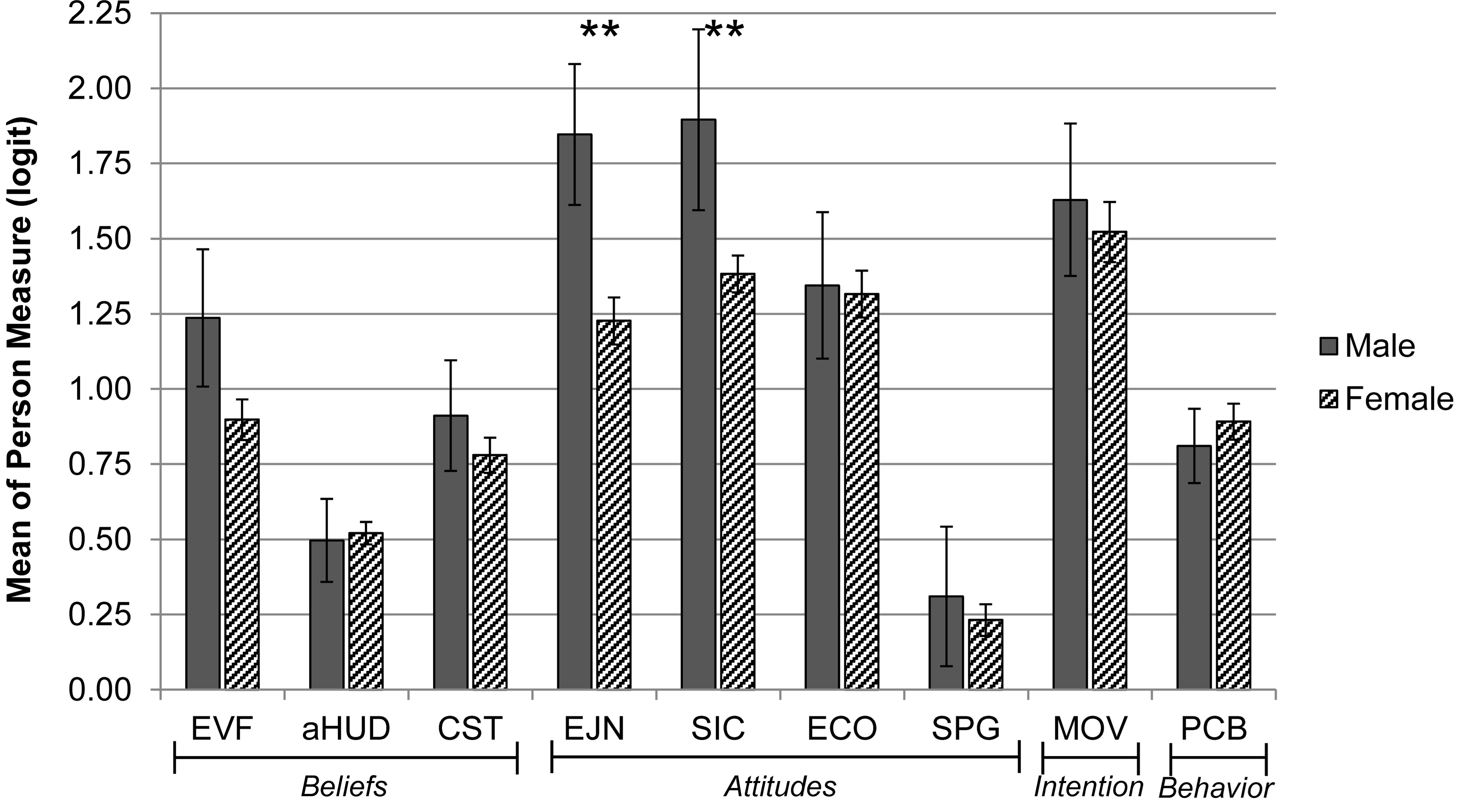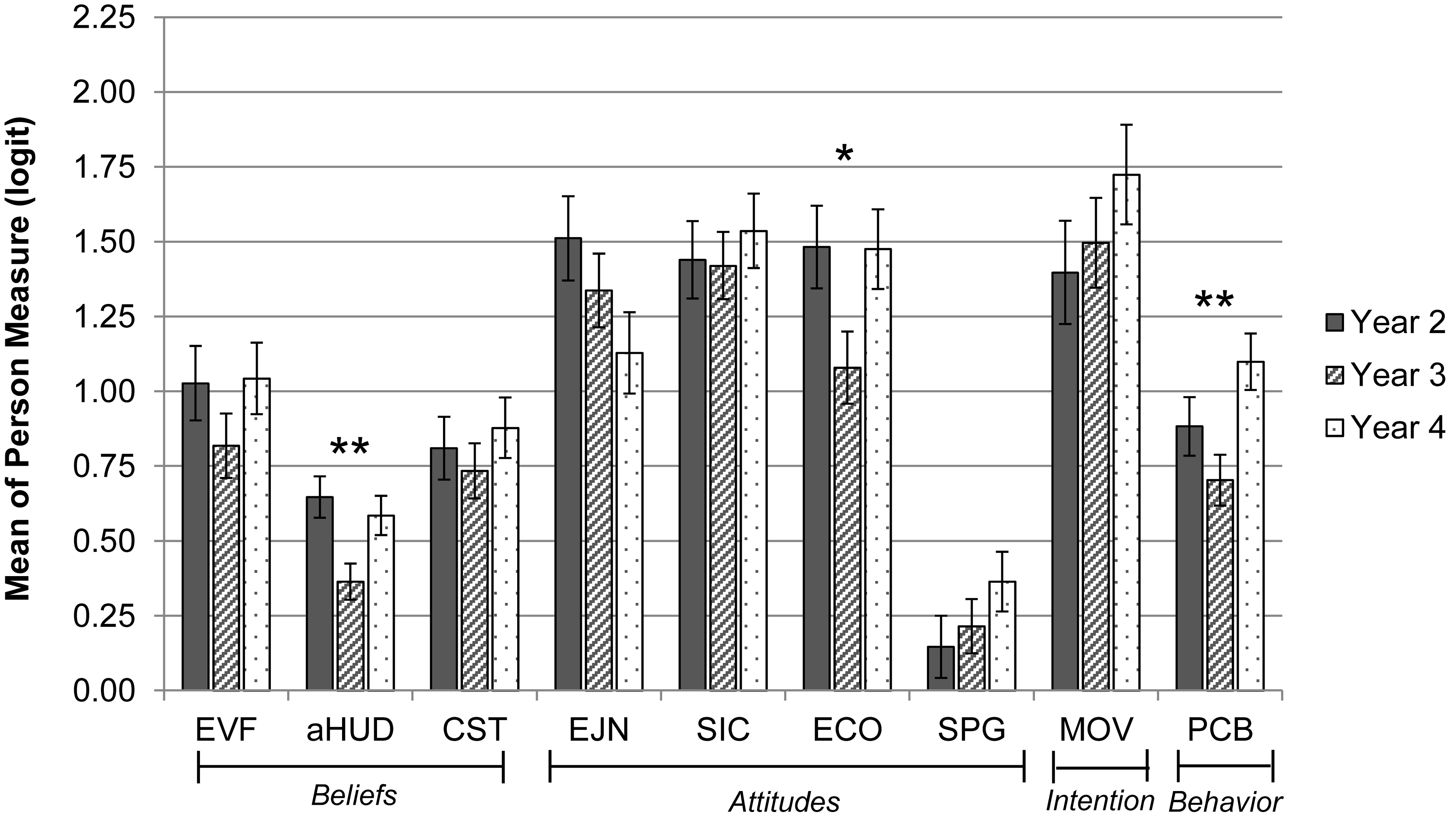Asia-Pacific Forum on Science Learning and Teaching, Volume 20, Issue 2, Article 3 (Jun., 2021 |
Gender and educational year effects

Figure 3. Independent sample t-test results of the used EAI scales based on gender. (Note: ** p < .01, * p < .05, no mark p > .05).Figure 3 visualizes the results of gender differences. Based on the independent sample t-test analyses, among the 10 environmental scales used in the current study, only two scales were found to exhibit significant gender differences with medium effect size. Those two scales were enjoyment of nature (EJN, t = 2.94, p-value = .004, d = 0.57), and support for interventionist conservation policies (SIC, t = 2.67, p-value = .008, d = 0.51). Interestingly, male (M = 1.85, SD = 1.33; M = 1.90, SD = 1.70, respectively) had higher averages than female (M = 1.23, SD = 1.06; M = 1.38, SD = 0.83, respectively) in both scales.
Figure 4. Analysis of variance (ANOVA) results of the used EAI scales based on years. (Note: ** p < .01, * p < .05, no mark p > .05).The ANOVA results for educational years found that only three scales exhibited significant differences. Those scales were anti-human utilization of and dominance over nature (aHUD, F [2,211] = 5.59, p = 0.004, ηp2 = 0.050), ecocentric concern (ECO, F [2,211) = 3.40, p = .035, ηp2 = 0.031] and personal conservation behaviour (PCB, F [2,211] = 4.87, p = .009, ηp2 = 0.044). Following the ANOVA test, Tukey multiple comparison test was performed as the post hoc test. Based on the finding from the post-hoc test, the current study found that the aHUD scale third year students (M = 0.36, SD = 0.50) had significantly (p-value < 0.01) lower average than the second (M = 0.65, SD = 0.69) and fourth year students (M = 0.59, SD = 0.42). An intriguing finding was found in the ECO scale, as the ANOVA test found that educational years significantly impact the ECO; however, even though the second (M = 1.48, SD = 1.37) and fourth (M = 1.48, SD = 0.91) year students had higher average than the third year students (M = 1.08, SD = 0.99), as visualized in Fig. 4, based on the post-hoc test, no statistically significant result was found. It may be the reason why the p-value from the ANOVA result was quite high (p = 0.035). Lastly, the post hoc test for PCB showed that fourth year students (M = 1.10, SD = 0.81) had significantly (p = .006) higher average than third year students. Meanwhile, no significant differences were found between fourth year and second year (M = 0.88, SD = 0.83, p = .497), or between second year and third year students (M = 0.70, SD = 0.71, p =.339).
Correlations among variables and testing the hypothesized model through structural equation modeling
Before testing the hypothesized model, both Pearson’s correlation and partial correlation tests were performed on the four environmental dimensions to find out the inter-correlation between the domains, and the mediator between one domain and another domain. Table 2 shows the results of the correlation tests.
Table 2. Pearson’s correlation and partial correlation results of the four environmental domains (** p <.01, * p < .05, no mark p > .05).
Variable I
Variable II
Pearson's Correlation
Partial Correlation
Control variable
EB
EA
EI
SEB
Beliefs (EB)
EA
0.578**
-
-
.555**
.491**
EI
0.209**
-
-.085
-
.072
Behavior (SEB)
0.492**
-
.369**
.460**
-
Attitudes (EA)
EI
0.468**
.435**
-
-
.402**
SEB
0.367**
.116
-
.267**
-
Intention (EI)
SEB
0.304**
.236**
.161*
-
-
It can be seen from Table 2 that the four domains were significantly (p < .01) correlated with one another. The highest correlation coefficient was found between EB and EA (r = .578), while the lowest was between EB and EI (r = .209). Additionally, based on the results from partial correlation test, three correlations were found to become non-significant when controlled by other domains. These were the correlations between EA and SEB when controlled by EB (r = 0.116, p = .090), EB and EI when controlled by EA (r = -0.085, p = .217), and EB and EI when controlled by SEB (r = 0.072, p = .292). Structural equation modeling (SEM) was used as the follow-up of the correlation test, to evaluate the hypotheses, and the hypothesized model of the structure of environmental beliefs, attitudes, intention, and behaviour of Indonesian preservice biology teachers. Figure 5 shows the SEM result. It can be seen from Figure 4 that two out of the three hypotheses, which are H1 and H2, were accepted, while H3, hypothesizing there is a significant path from environmental attitudes to SEB, was rejected.

Figure 5. The accepted model (χ2/df = 1.55, p-value = .214, SRMR = .021, GFI = .996, AGFI =.964, NFI =.993, IFI =.997, TLI =.984, CFI =.997, RMSEA =.050)Interview results
The results from interviewing six Indonesian preservice biology teachers supported the accepted model. Most of them (88%) believed that human activities, including their activities, caused the environmental problems that have been emerging in Indonesia; and this belief has stimulated them to behave more pro-environmentally in their own life. These are quotes from their responses (“…” corresponds to the truncated response):
[translated from the Bahasa/Indonesian language] “… I believe that all the environmental problems are caused by citizens, because they tend to do not think much when doing something harmful to the environment… because it is caused by them, including myself, I also believe that only us can reduce the problems; thus, I am frequently involved in the protecting environment-related activities in my neighbourhood” (FNKE16).
[translated from the Bahasa/Indonesian language] “… I have been believing all the emergent environmental problem is caused by people surrounding me and myself as well… specifically driven by their and my own needs and desires… I have tried to control my own desires by so far not throwing trash in the inappropriate places and saving water usage…” (MSTY14).
[translated from the Bahasa/Indonesian language] “… The high economic demands that Indonesian people have make them doing what they want to the environment, including harmful actions… even in a very small action… because I believe if many people do the very small harmful action it will eventually cause the bigger thing… thus in order to prevent it, I have tried small things to preserve the environment by doing small actions, such as throwing trash in appropriate places and studying environmental science” (FTTN14).
Moreover, we also captured that they all acknowledged that their major in the university contributed to making them see and observe nature and the environment. It led them to understand better the balance and beauty of nature and the environment, which made them feel more connectedness with it, and with more intention to protect nature. Such statements are:
[translated from the Bahasa/Indonesian language] “… My biology education department provides several courses related to the environmental and the problems within it…also, many professors provide many activities that do work in nature, such as direct observation and field trips. These efforts have made me more aware of the environmental problems… also, increase the level of comfortableness being in nature… because of this sometimes I think to join environmental-related activist club” (MSTY14).
[translated from the Bahasa/Indonesian language] “… I feel my major now (biology education) really helps me in increasing my environmental awareness… by learning the interdependency between humans, plants, animals and nature… protecting nature is similar to protecting my own self and other humans…” (FRNI15).
Regarding the issue of intention, all of them noted that even though they had the intention to behave more pro-environmentally to reduce the environmental problems, sometimes they could not realize this in their everyday life. They stated the reason was that their surroundings, like rules, other people, or social media, do not support their intention, leading them to fail to realize their pro-environment behavioural intention. These are some statements of the Indonesian preservice biology teachers regarding this issue:
[translated from the Bahasa/Indonesian language] “… Indeed everyone has the intention to behave more friendly to the environment. But, the realization of it is not that easy and apparent. Government with their rules needs to support intention to be realized…” (MRFI16).
[translated from the Bahasa/Indonesian language] “… I do always have the intention to behave pro-environmentally, but when I see my friends do not behave friendly to the environment, suddenly my intention is gone… thus I believe surrounding people have an impact in making someone behaving more pro-environmental ” (MSTY14)

